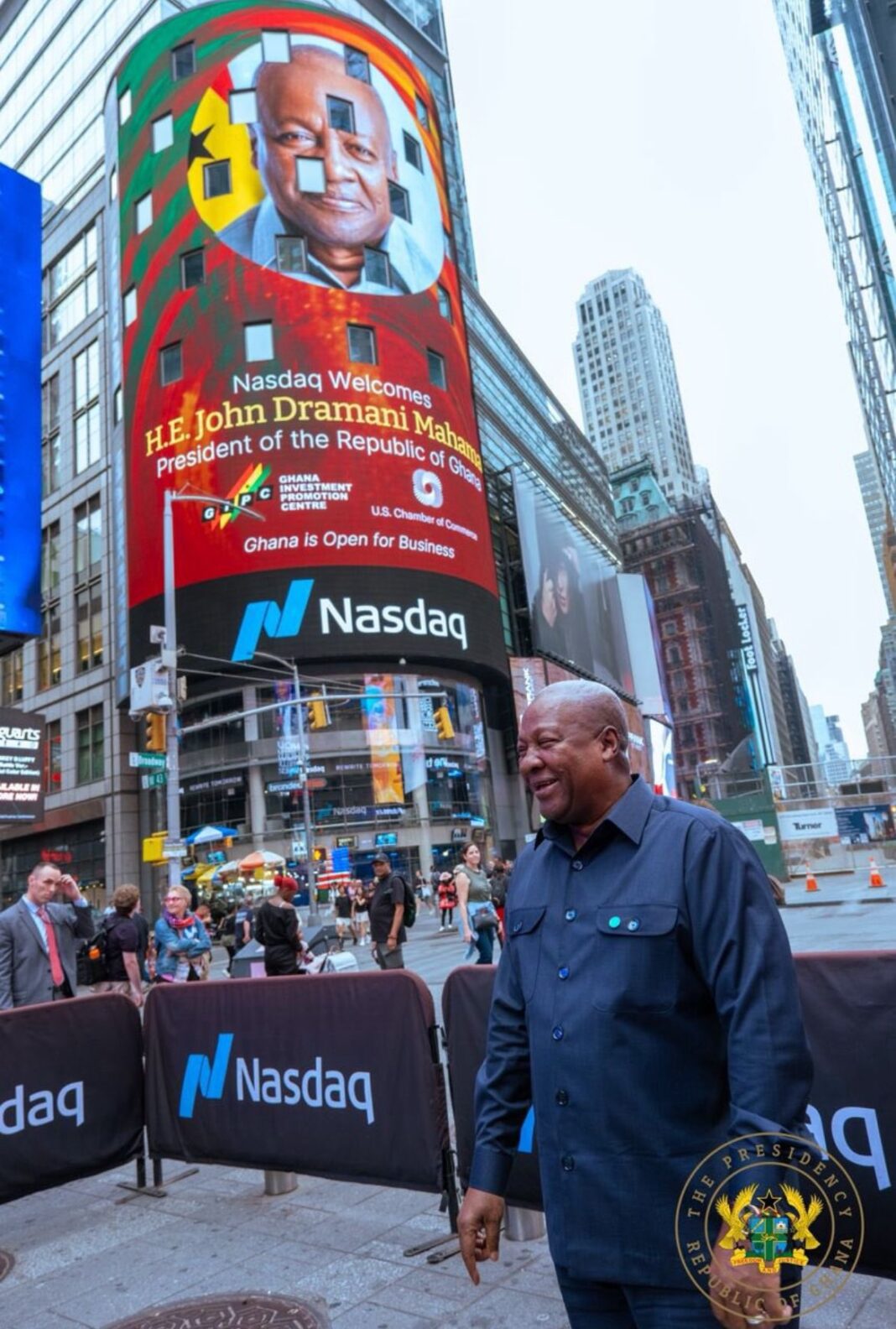John Dramani Mahama arrived in New York this week with twin stages: a policy pitch at the United Nations General Assembly and a high-visibility business outreach in Manhattan’s financial district, where his image appeared on Nasdaq’s Times Square billboard and he rang the opening bell. Both gestures were part of a coordinated push to sell a message “Reset Ghana” and “Ghana is open for business” but together they exposed enduring tensions about substance versus spectacle, domestic credibility, and the politics of image making for fragile economies.
Mahama’s UN remarks were pitched squarely at global institutions and donors. He called for a re-engineered development agenda, what his entourage labeled the “Accra Reset” arguing that the architecture of global governance needs to be more responsive to the priorities of lower-income states, especially on health, climate finance, and debt treatment. The speech emphasized sovereignty, shared value, and African agency in determining development pathways themes that resonate widely among Global South diplomats and development activists.
That rhetoric matters: Ghana’s economy is under strain after years of fiscal stress, a large IMF program, and high public debt burdens. An appeals-to-reform message at the UN aims to position Accra as both a voice for structural change and an attractive partner for targeted finance and technical cooperation. In diplomatic terms, the speech was a classic double act, advocate for systemic reform while signaling policy credibility to investors and multilateral lenders.
But optics matter almost as much as policy language in global capitals. The Nasdaq billboard and bell ceremony were unmistakably PR: a visual shorthand that Ghana intends to court capital markets, international firms, and diaspora investors. State media and Ghanaian outlets framed it as historic and celebratory, with the president’s photo looming over Times Square and headlines touting Ghana as “open for business.” Those visuals are designed for immediate impact—social feeds, diaspora pride, and investor photo-ops.
Yet that spectacle also drew sharp domestic criticism. Opposition voices, civil-society commentators and some journalists framed the Times Square moment as tone-deaf—an expensive photo opportunity when many Ghanaians still confront high inflation, utility subsidies under strain, and lingering questions about governance. Critics argued the billboard was a superficial fix that risks distracting from nitty-gritty reforms—fiscal consolidation, anti-corruption follow-through, and real improvements in public services—that investors actually evaluate. A recurring line of critique on Ghanaian social media questioned whether the money and political bandwidth spent on PR might have been better deployed at home.
There is a deeper credibility question embedded here. Investor attraction depends on durable policy signals: predictable regulation, transparent procurement, fiscal discipline, and judicial independence. Billboards and bell-ringing create headlines; sustained foreign direct investment requires predictable legal frameworks and reliable macroeconomic footing. The risk is reputational — a flash of glamor that, if not backed by consistent reform, can accentuate investor scepticism or prompt short-lived capital flows that evaporate when fundamentals disappoint.
From a diplomatic angle, the dual approach has upsides. The UN stage gave Mahama legitimacy to press collective diplomatic claims—on restructuring development finance and marshaling support for climate adaptation—while New York financial theatrics signalled openness to private partners. Together these moves can amplify Ghana’s negotiating power: diplomatic visibility helps attract concessional and blended finance; commercial visibility can catalyze private co-investors into targeted projects. The challenge is sequencing and credibility: multilateral lenders and sophisticated investors will look past the billboard to governance metrics.
There are political risks too. Domestic critics will deploy the Nasdaq imagery to underscore perceived elite disconnect, compounding electoral vulnerabilities. Mahama’s political coalition must therefore convert global attention into tangible gains—project finance clinched, investor missions committed, or binding agreements for infrastructure and industrial projects—otherwise opponents will use the optics as evidence that the administration prioritises image over impact.
Finally, there is a communications lesson for emerging market leaders. Branding a country on a global billboard can catalyze attention, but in a world of instant scrutiny it also invites testing: journalists, investors, and domestic constituencies will run fast checks on statistics, procurement records, and policy timelines. For Ghana, the test now is not the photo in Times Square but whether Mahama’s UN appeals and the Nasdaq outreach translate into measurable outcomes—new direct investment, concrete debt relief terms, or tangible climate finance commitments—that improve ordinary Ghanaians’ lives. If they do, the billboard becomes a symbol of successful diplomacy; if not, it risks becoming an emblem of performative politics.
Bottom line: Mahama’s UN speech and Nasdaq appearance were two halves of the same strategic brief: lobby for systemic adjustments in global governance while courting private capital. Both are defensible and potentially complementary. But in Ghana’s delicate political economy, optics and substance must move in tandem. Otherwise the Times Square moment will be remembered as an expensive photograph rather than the opening move in a sustained program of economic recovery and inclusive growth

